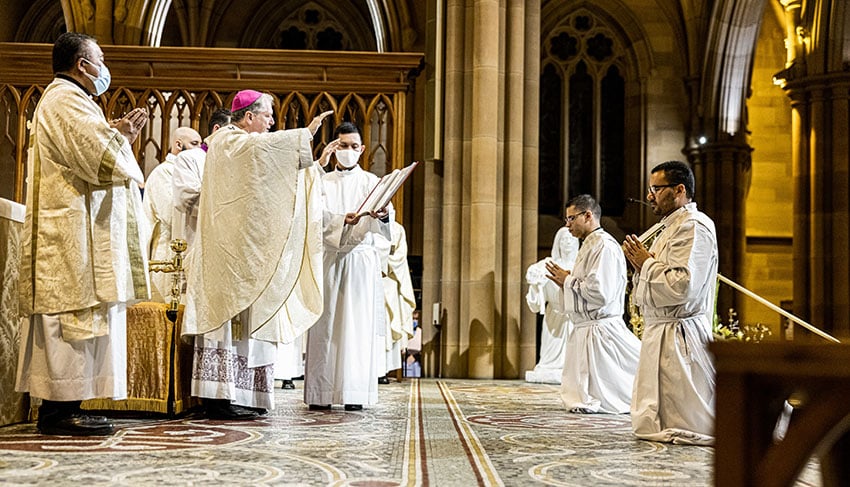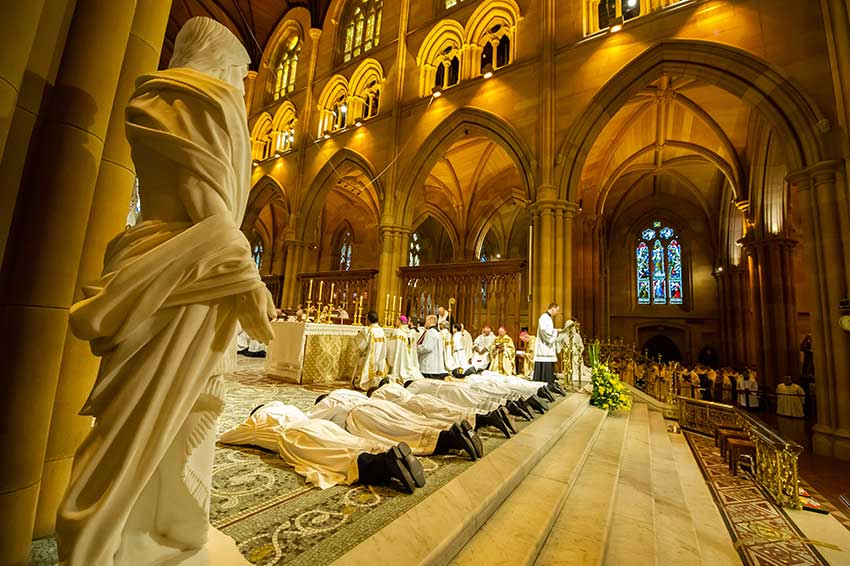
Next Saturday morning (6 August) five young men will prostrate themselves on the richly mosaicked sanctuary of Saint Mary’s Cathedral.
The congregation begs God the Father to pour out the “gifts of heaven” on these chosen men and invoked the intercession of the Church Triumphant in the Litany of the Saints.
The moment of prostration in the Rite of Ordination represents much of what is happening on a spiritual level in the lives of the soon-to-be priests.
When a person is prostrate, every part of his body is as close to the ground as possible.
This posture, voluntarily undertaken, speaks to a complete emptying of the self before the Lord.
This is also why – through their promises of prayer, celibacy and obedience – candidates for the priesthood lay down some of the greatest goods this world has to offer.
“We say ‘what goes up must come down’. In the sacrament of ordination, ‘what goes down must come up.'”
Similar to the “old self” that dies with conversion to the “new self” in Christ (Ephesians 4:22-24), prostration signifies a kind of death to self.
And yet, strangely, the congregation at Saint Mary’s Cathedral will not be present as mourners. The people in the pews will share a belief with the men in the sanctuary that something beautiful rises when a life is laid down in service to God.
Herein lies a great paradox of the priesthood.
When a man empties himself of worldly glory – symbolised in the gesture of prostration – he shares in the self-emptying of our “great high priest”, Jesus Christ.
The self-emptying of Christ saw God draw closer to man. The self-emptying of someone called to priesthood allows man to draw closer to God.
We say “what goes up must come down”. In the sacrament of ordination, “what goes down must come up.”

A man rises from his prostration in the Rite of Ordination having signified his entire vocation. His is a life of heroic service. Except now risen, he is not alone.
He rises with the people of God by his side to both support him and finally provide a focus for the love of his priestly heart.
A priest consecrates his entire life to drawing the faithful closer to God. He hopes to one day share the words of the Psalmist: “I would lead the rejoicing crowd into the house of God, amid cries of gladness and thanksgiving, the throng wild with joy.” (Ps. 41)
This is why the Church rejoices when a man lays down his life to become a priest of Jesus Christ.
In these five priests, the congregation will see the Bridegroom lay down his life again for his Bride.
They will feel a strengthening of their own hope to be saved through the work of these priests.
“His seminary formation, and now the Sacrament of Holy Orders, has shaped and inflamed his heart to love the Bride of Christ with the heart of the Bridegroom.”
They will sense an increased zeal to detach from what is fleeting in order to hold on more firmly to what endures.
It is true that a man must be ready to lay down his life to share in the priesthood of Christ, but it is truer still that he rises to a most beautiful spiritual matrimony.
After rising from his prostration, and receiving the grace of Holy Orders, the new priest turns around to face the congregation; his new Bride.
Thus far, he served the Lord by gazing upon the face of his Son. His heart was for Christ, but now it is also with Christ for his Bride; the Church.
His seminary formation, and now the Sacrament of Holy Orders, has shaped and inflamed his heart to love the Bride of Christ with the heart of the Bridegroom.
He rises from his prostration overwhelmed, to be finally presented with the Bride he will love for the rest of his life.
